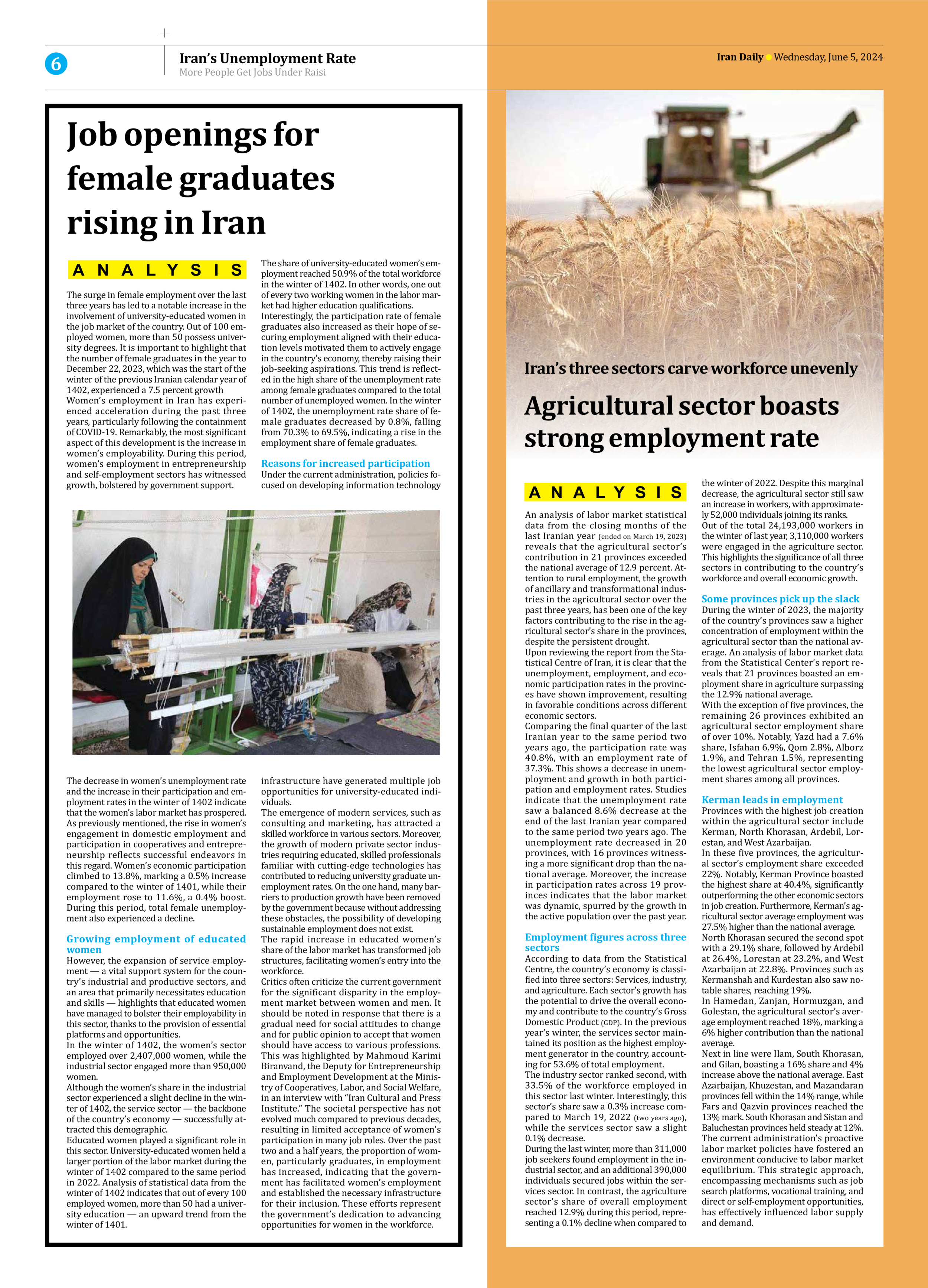
Job openings for female graduates rising in Iran
The surge in female employment over the last three years has led to a notable increase in the involvement of university-educated women in the job market of the country. Out of 100 employed women, more than 50 possess university degrees. It is important to highlight that the number of female graduates in the year to December 22, 2023, which was the start of the winter of the previous Iranian calendar year of 1402, experienced a 7.5 percent growth
Women’s employment in Iran has experienced acceleration during the past three years, particularly following the containment of COVID-19. Remarkably, the most significant aspect of this development is the increase in women’s employability. During this period, women’s employment in entrepreneurship and self-employment sectors has witnessed growth, bolstered by government support.
The decrease in women’s unemployment rate and the increase in their participation and employment rates in the winter of 1402 indicate that the women’s labor market has prospered. As previously mentioned, the rise in women’s engagement in domestic employment and participation in cooperatives and entrepreneurship reflects successful endeavors in this regard. Women’s economic participation climbed to 13.8%, marking a 0.5% increase compared to the winter of 1401, while their employment rose to 11.6%, a 0.4% boost. During this period, total female unemployment also experienced a decline.
Growing employment of educated women
However, the expansion of service employment — a vital support system for the country’s industrial and productive sectors, and an area that primarily necessitates education and skills — highlights that educated women have managed to bolster their employability in this sector, thanks to the provision of essential platforms and opportunities.
In the winter of 1402, the women’s sector employed over 2,407,000 women, while the industrial sector engaged more than 950,000 women.
Although the women’s share in the industrial sector experienced a slight decline in the winter of 1402, the service sector — the backbone of the country’s economy — successfully attracted this demographic.
Educated women played a significant role in this sector. University-educated women held a larger portion of the labor market during the winter of 1402 compared to the same period in 2022. Analysis of statistical data from the winter of 1402 indicates that out of every 100 employed women, more than 50 had a university education — an upward trend from the winter of 1401.
The share of university-educated women’s employment reached 50.9% of the total workforce in the winter of 1402. In other words, one out of every two working women in the labor market had higher education qualifications.
Interestingly, the participation rate of female graduates also increased as their hope of securing employment aligned with their education levels motivated them to actively engage in the country’s economy, thereby raising their job-seeking aspirations. This trend is reflected in the high share of the unemployment rate among female graduates compared to the total number of unemployed women. In the winter of 1402, the unemployment rate share of female graduates decreased by 0.8%, falling from 70.3% to 69.5%, indicating a rise in the employment share of female graduates.
Reasons for increased participation
Under the current administration, policies focused on developing information technology infrastructure have generated multiple job opportunities for university-educated individuals.
The emergence of modern services, such as consulting and marketing, has attracted a skilled workforce in various sectors. Moreover, the growth of modern private sector industries requiring educated, skilled professionals familiar with cutting-edge technologies has contributed to reducing university graduate unemployment rates. On the one hand, many barriers to production growth have been removed by the government because without addressing these obstacles, the possibility of developing sustainable employment does not exist.
The rapid increase in educated women’s share of the labor market has transformed job structures, facilitating women’s entry into the workforce.
Critics often criticize the current government for the significant disparity in the employment market between women and men. It should be noted in response that there is a gradual need for social attitudes to change and for public opinion to accept that women should have access to various professions. This was highlighted by Mahmoud Karimi Biranvand, the Deputy for Entrepreneurship and Employment Development at the Ministry of Cooperatives, Labor, and Social Welfare, in an interview with “Iran Cultural and Press Institute.” The societal perspective has not evolved much compared to previous decades, resulting in limited acceptance of women’s participation in many job roles. Over the past two and a half years, the proportion of women, particularly graduates, in employment has increased, indicating that the government has facilitated women’s employment and established the necessary infrastructure for their inclusion. These efforts represent the government’s dedication to advancing opportunities for women in the workforce.







